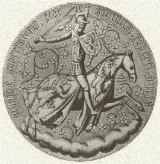
Robert Stewart, 1st Duke of Albany
Encyclopedia
Robert Stewart, Duke of Albany (c. 1340 – 3 September 1420), a member of the Scottish
royal house, served as Regent
(at least partially) to three different Scottish monarchs (Robert II
, Robert III
, and James I
). He also held the titles of Earl of Menteith
(28 February 1361), Earl of Fife
(1361; resigned in 1372), Earl of Buchan
(1394; resigned in 1406) and Earl of Atholl
(1403, for the duration of Robert III's life only), in addition to his 1398 creation as Duke of Albany
. A ruthless politician, Albany was widely regarded as having caused the murder of his nephew, the Duke of Rothesay
, and brother to the future King James I of Scotland. James was held in captivity in England for eighteen years, during which time Albany served as Regent in Scotland, king in all but name. He died in 1420 and was succeeded by his son, Murdoch Stewart, Duke of Albany, who would be executed for treason when James returned to Scotland in 1425, causing the almost complete ruin of the Albany Stewarts.
(1316–1390) and of Elizabeth Mure
of Rowallan. He was legitimated in 1349 by his parents' marriage. Robert's grandfather was Walter Stewart, 6th High Steward of Scotland
(1293–1326) and his father was the first monarch of the House of Stewart. His great-grandfather was Robert the Bruce (1274–1329), legendary victor of the Battle of Bannockburn
.
Robert Stewart was raised in a large family with many siblings. His older brother John Stewart (1337–1406) became Earl of Carrick
in 1368, and would later be crowned King of Scotland under the name Robert III
.
In 1361 Stewart married Margaret Graham, Countess of Menteith
(1334–1380), a wealthy divorcee who took Robert as her fourth husband. His sister-in-law's claim to the Earldoms of Menteith and Fife allowed him to assume those titles, becoming Earl of Menteith and Earl of Fife. In 1362 the couple had a son and heir, Murdoch Stewart, (1362–1425) who would in time inherit his father's titles and estates.
Stewart was responsible for the construction of Doune Castle
, which remains largely intact today. When Stewart was created Earl of Menteith
, he was granted the lands on which Doune Castle
now stands. Building may have started any time after this, and the castle was at least partially complete in 1381, when a charter was sealed here.
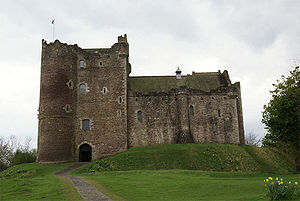
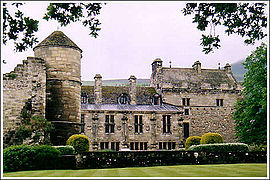 Scottish politics in the late 14th century was unstable and bloody, and much of Albany's career would be spent acquiring territory, land and titles, often by violent means. In 1389 his son Murdoch Stewart was appointed Justiciar of Scotland North of the Forth, and father and son would now work together to expand their family interest, bringing them into violent confrontation with other members of the nobility such as Donald McDonald, 2nd Lord of the Isles
Scottish politics in the late 14th century was unstable and bloody, and much of Albany's career would be spent acquiring territory, land and titles, often by violent means. In 1389 his son Murdoch Stewart was appointed Justiciar of Scotland North of the Forth, and father and son would now work together to expand their family interest, bringing them into violent confrontation with other members of the nobility such as Donald McDonald, 2nd Lord of the Isles
.
During the reign of their infirm father as King Robert II
(1371–1390), Robert Stewart and his older brother Lord Carrick
functioned as Regents of Scotland, Kings in all but name, with Albany serving as High Chamberlain of Scotland
. He also led several military expeditions and raids into the Kingdom of England
.
In 1389, the Earl of Carrick became incapacitated in an accident and, though he nevertheless acceded to the throne as King Robert III in 1390, this "sickness of the body" caused control of the kingdom eventually to devolve in 1399 to his son and heir apparent, David Stewart, Duke of Rothesay
, who held the first dukedom created in the Scottish Peerage
. Although In 1398 Robert was himself appointed Duke of Albany, bringing him still greater power and wealth, power had begun to shift away from Albany and towards his nephew.
where he died in March 1402. Rothesay's death probably lay with Albany and Douglas who would have looked upon the possibility of the young prince acceding to the throne with great apprehension. Albany certainly fell under suspicion but he was cleared of all blame by a general council, which found that 'by divine providence and not otherwise, it is discerned that he [Duke Rothesay] departed from this life.'
However, even though Albany was exonerated from blame, suspicions of foul play persisted, suspicions which never left Rothesay's younger brother the future James I of Scotland, and which would eventually lead to the downfall of the Albany Stewarts. John Debrett, writing in 1805, was in no doubt of Duke Robert's motives and guilt:
After Rothesay's death, the King began to fear for his second son James, who fled Scotland for his own safety. Debrett continues:
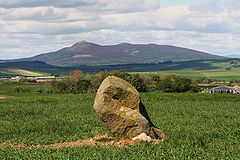 After the death of his brother King Robert III, Albany ruled Scotland as Regent, king in all but name. His young nephew, the future James I of Scotland
After the death of his brother King Robert III, Albany ruled Scotland as Regent, king in all but name. His young nephew, the future James I of Scotland
, would remain in exile and imprisonment in England for 18 years. Perhaps unsurprisingly Albany made little effort to secure the young Prince's ransom and return to Scotland, focusing his energies instead on securing his own power and interest.
Albany's political triumph did not settle his differences with the other members of the nobility, in particular Donald McDonald, 2nd Lord of the Isles
, who in 1411 led an army of clansmen from the Western Highlands into open battle with the Stewarts. This conflict began when Albany had attempted to secure the Earldom of Ross for his second son John, despite McDonald's better claim. At the Battle of Harlaw
(known as "Red Harlaw" on account of its savagery) on 24 July 1411, losses were heavy on both sides, though McDonald's eventual withdrawal allowed the Stewarts to claim a strategic victory. The Stewart army was led by Albany's nephew, Alexander Stewart, Earl of Mar
, who would later sit on the jury of knights and peers which convicted Albany's son Murdoch Stewart, Duke of Albany and two of his sons of treason, virtually annihilating the Albany Stewarts.
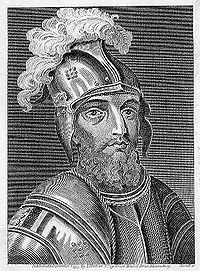 Albany married twice. Firstly, in 1361, he married Margaret Graham, Countess of Menteith
Albany married twice. Firstly, in 1361, he married Margaret Graham, Countess of Menteith
, (1334–1380) a wealthy divorcee who took him as her fourth husband. His sister-in-law's claim to the Earldoms of Menteith and Fife allowed him to assume those titles after marriage. The couple had eight children, seven daughters and a son:
Margaret died in 1380 and Albany subsequently married Muriella de Keith, with whom he had four children, the elder of whom was John Stewart, 2nd Earl of Buchan
(1381–1424). Buchan fought in France against the English during the Hundred Years War, serving with distinction, but was killed at the Battle of Verneuil
on 17 August 1424.

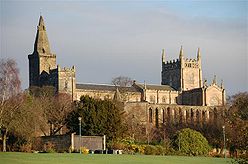 The Duke of Albany died in 1420 in Stirling Castle
The Duke of Albany died in 1420 in Stirling Castle
and lies buried in Dunfermline Abbey
in Fife
. He was succeeded as Duke of Albany and Regent of Scotland by his son, Murdoch Stewart, Duke of Albany. But Murdoch would not enjoy his power for long. In 1425 the exiled King James, captive in England for 18 years, finally returned to Scotland, and executed Murdoch and most of his family for treason, causing the almost complete ruin of the Albany Stewarts.
Murdoch Stewart's sole surviving male heir was his youngest son, James the Fat
, who fled to Ireland
after a brief rebellion against the King over the arrest of his father and brothers. James remained in Ireland, unable to return, and died there in 1429. He was never able to inherit his father's titles, since they had been declared forfeit.
Albany's great-grandson, James "Beg" Stewart
, (c. 1410-1470) would eventually secure a pardon from the King and return to Scotland, though the family would never recover their lost estates. James "Beg" Stewart is the ancestor of the Stewarts of Ardvorlich on Lochearnside, whose family history is recounted by Sir Walter Scott in A Legend of Montrose
.
's Stewart Trilogy covers the period when Albany was an important figure in Scotland.
Scotland
Scotland is a country that is part of the United Kingdom. Occupying the northern third of the island of Great Britain, it shares a border with England to the south and is bounded by the North Sea to the east, the Atlantic Ocean to the north and west, and the North Channel and Irish Sea to the...
royal house, served as Regent
Regent
A regent, from the Latin regens "one who reigns", is a person selected to act as head of state because the ruler is a minor, not present, or debilitated. Currently there are only two ruling Regencies in the world, sovereign Liechtenstein and the Malaysian constitutive state of Terengganu...
(at least partially) to three different Scottish monarchs (Robert II
Robert II of Scotland
Robert II became King of Scots in 1371 as the first monarch of the House of Stewart. He was the son of Walter Stewart, hereditary High Steward of Scotland and of Marjorie Bruce, daughter of Robert I and of his first wife Isabella of Mar...
, Robert III
Robert III of Scotland
Robert III was King of Scots from 1390 to his death. His given name was John Stewart, and he was known primarily as the Earl of Carrick before ascending the throne at age 53...
, and James I
James I of Scotland
James I, King of Scots , was the son of Robert III and Annabella Drummond. He was probably born in late July 1394 in Dunfermline as youngest of three sons...
). He also held the titles of Earl of Menteith
Earl of Menteith
The Mormaer or Earl of Menteith was originally the ruler of the province of Menteith in the Middle Ages. The first mormaer is usually regarded as Gille Críst, simply because he is the earliest on record. The title was held in a continuous line from Gille Crist until Muireadhach IV , although the...
(28 February 1361), Earl of Fife
Earl of Fife
The Earl of Fife or Mormaer of Fife referred to the Gaelic comital lordship of Fife which existed in Scotland until the early 15th century....
(1361; resigned in 1372), Earl of Buchan
Earl of Buchan
The Mormaer or Earl of Buchan was originally the provincial ruler of the medieval province of Buchan. Buchan was the first Mormaerdom in the High Medieval Kingdom of the Scots to pass into the hands of a non-Scottish family in the male line. The earldom had three lines in its history, not counting...
(1394; resigned in 1406) and Earl of Atholl
Earl of Atholl
The Mormaer of Earl of Atholl refers to a medieval comital lordship straddling the highland province of Atholl , now in northern Perthshire. Atholl is a special Mormaerdom, because a King of Atholl is reported from the Pictish period. The only other two Pictish kingdoms to be known from...
(1403, for the duration of Robert III's life only), in addition to his 1398 creation as Duke of Albany
Duke of Albany
Duke of Albany is a peerage title that has occasionally been bestowed on the younger sons in the Scottish, and later the British, royal family, particularly in the Houses of Stuart and Hanover....
. A ruthless politician, Albany was widely regarded as having caused the murder of his nephew, the Duke of Rothesay
Duke of Rothesay
Duke of Rothesay was a title of the heir apparent to the throne of the Kingdom of Scotland before 1707, of the Kingdom of Great Britain from 1707 to 1801, and now of the United Kingdom of Great Britain and Northern Ireland....
, and brother to the future King James I of Scotland. James was held in captivity in England for eighteen years, during which time Albany served as Regent in Scotland, king in all but name. He died in 1420 and was succeeded by his son, Murdoch Stewart, Duke of Albany, who would be executed for treason when James returned to Scotland in 1425, causing the almost complete ruin of the Albany Stewarts.
Early life and ancestry
Robert Stewart was an illegitimate son of the future King Robert II of ScotlandRobert II of Scotland
Robert II became King of Scots in 1371 as the first monarch of the House of Stewart. He was the son of Walter Stewart, hereditary High Steward of Scotland and of Marjorie Bruce, daughter of Robert I and of his first wife Isabella of Mar...
(1316–1390) and of Elizabeth Mure
Elizabeth Mure
Elizabeth Mure was mistress and then wife of Robert, High Steward of Scotland, and Guardian of Scotland , who later became King Robert II of Scotland.-History:...
of Rowallan. He was legitimated in 1349 by his parents' marriage. Robert's grandfather was Walter Stewart, 6th High Steward of Scotland
Walter Stewart, 6th High Steward of Scotland
Walter Stewart was the 6th hereditary High Steward of Scotland. He was also the father of King Robert II of Scotland.-Biography:...
(1293–1326) and his father was the first monarch of the House of Stewart. His great-grandfather was Robert the Bruce (1274–1329), legendary victor of the Battle of Bannockburn
Battle of Bannockburn
The Battle of Bannockburn was a significant Scottish victory in the Wars of Scottish Independence...
.
Robert Stewart was raised in a large family with many siblings. His older brother John Stewart (1337–1406) became Earl of Carrick
Earl of Carrick
The Earl of Carrick was the head of a comital lordship of Carrick in southwestern Scotland. The title emerged in 1186, when Donnchad, son of Gille Brigte, Lord of Galloway, became Mormaer or Earl of Carrick in compensation for exclusion from the whole Lordship of Galloway...
in 1368, and would later be crowned King of Scotland under the name Robert III
Robert III of Scotland
Robert III was King of Scots from 1390 to his death. His given name was John Stewart, and he was known primarily as the Earl of Carrick before ascending the throne at age 53...
.
In 1361 Stewart married Margaret Graham, Countess of Menteith
Margaret Graham, Countess of Menteith
Margaret Graham, Countess of Menteith was a Scottish noblewoman. She married four times, becoming Countess of Menteith and, in 1361, Duchess of Albany. Her fourth and last husband was Sir Robert Stewart, 1st Duke of Albany, who would go on to be Regent of Scotland from 1406 until his death in 1420...
(1334–1380), a wealthy divorcee who took Robert as her fourth husband. His sister-in-law's claim to the Earldoms of Menteith and Fife allowed him to assume those titles, becoming Earl of Menteith and Earl of Fife. In 1362 the couple had a son and heir, Murdoch Stewart, (1362–1425) who would in time inherit his father's titles and estates.
Stewart was responsible for the construction of Doune Castle
Doune Castle
Doune Castle is a medieval stronghold near the village of Doune, in the Stirling district of central Scotland. The castle is sited on a wooded bend where the Ardoch Burn flows into the River Teith. It lies north-west of Stirling, where the Teith flows into the River Forth...
, which remains largely intact today. When Stewart was created Earl of Menteith
Earl of Menteith
The Mormaer or Earl of Menteith was originally the ruler of the province of Menteith in the Middle Ages. The first mormaer is usually regarded as Gille Críst, simply because he is the earliest on record. The title was held in a continuous line from Gille Crist until Muireadhach IV , although the...
, he was granted the lands on which Doune Castle
Doune Castle
Doune Castle is a medieval stronghold near the village of Doune, in the Stirling district of central Scotland. The castle is sited on a wooded bend where the Ardoch Burn flows into the River Teith. It lies north-west of Stirling, where the Teith flows into the River Forth...
now stands. Building may have started any time after this, and the castle was at least partially complete in 1381, when a charter was sealed here.
Politics and war


Domhnall of Islay, Lord of the Isles
Donald, or properly, Dómhnall Íle , was the son and successor of John of Islay, Lord of the Isles and chief of Clan Donald. The Lordship of the Isles was based in and around the Scottish west-coast island of Islay, but under Domhnall's father had come to include many of the other islands off the...
.
During the reign of their infirm father as King Robert II
Robert II of Scotland
Robert II became King of Scots in 1371 as the first monarch of the House of Stewart. He was the son of Walter Stewart, hereditary High Steward of Scotland and of Marjorie Bruce, daughter of Robert I and of his first wife Isabella of Mar...
(1371–1390), Robert Stewart and his older brother Lord Carrick
Robert III of Scotland
Robert III was King of Scots from 1390 to his death. His given name was John Stewart, and he was known primarily as the Earl of Carrick before ascending the throne at age 53...
functioned as Regents of Scotland, Kings in all but name, with Albany serving as High Chamberlain of Scotland
Chamberlain of Scotland
Holders of the office of Lord Chamberlain of Scotland are known from about 1124.It was ranked by King Malcolm as the third great Officer of State, called Camerarius Domini Regis, and had a salary of £200 per annum alloted to him...
. He also led several military expeditions and raids into the Kingdom of England
Kingdom of England
The Kingdom of England was, from 927 to 1707, a sovereign state to the northwest of continental Europe. At its height, the Kingdom of England spanned the southern two-thirds of the island of Great Britain and several smaller outlying islands; what today comprises the legal jurisdiction of England...
.
In 1389, the Earl of Carrick became incapacitated in an accident and, though he nevertheless acceded to the throne as King Robert III in 1390, this "sickness of the body" caused control of the kingdom eventually to devolve in 1399 to his son and heir apparent, David Stewart, Duke of Rothesay
David Stewart, Duke of Rothesay
David Stewart was the heir to the throne of Scotland from 1390 and the first Duke of Rothesay from 1398. He also held the titles of Earl of Atholl and Earl of Carrick...
, who held the first dukedom created in the Scottish Peerage
Peerage of Scotland
The Peerage of Scotland is the division of the British Peerage for those peers created in the Kingdom of Scotland before 1707. With that year's Act of Union, the Kingdom of Scotland and the Kingdom of England were combined into the Kingdom of Great Britain, and a new Peerage of Great Britain was...
. Although In 1398 Robert was himself appointed Duke of Albany, bringing him still greater power and wealth, power had begun to shift away from Albany and towards his nephew.
Murder of the Duke of Rothesay
However, the English soon invaded Scotland, and serious differences emerged between Albany and Rothesay. In 1401, Rothesay was accused of unjustifiably appropriating sums from the customs of the burghs on the east coast and confiscating the revenues of the temporalities of the vacant bishopric of St Andrews. Rothesay had also in conjunction with his uncle, Alexander Stewart, Earl of Buchan, confronted Albany's influence in central Scotland—as soon his lieutenancy expired in 1402 Albany acted swiftly and ruthlessly. Rothesay was arrested and imprisoned in Albany's Falkland CastleFalkland Palace
Falkland Palace in Falkland, Fife, Scotland, is a former royal palace of the Scottish Kings. Today it is in the care of the National Trust for Scotland, and serves as a tourist attraction.-Early years:...
where he died in March 1402. Rothesay's death probably lay with Albany and Douglas who would have looked upon the possibility of the young prince acceding to the throne with great apprehension. Albany certainly fell under suspicion but he was cleared of all blame by a general council, which found that 'by divine providence and not otherwise, it is discerned that he [Duke Rothesay] departed from this life.'
However, even though Albany was exonerated from blame, suspicions of foul play persisted, suspicions which never left Rothesay's younger brother the future James I of Scotland, and which would eventually lead to the downfall of the Albany Stewarts. John Debrett, writing in 1805, was in no doubt of Duke Robert's motives and guilt:
- "This Robert, Duke of Albany, having obtained the entire government from his brother, King Robert, he caused the Duke of Rothesay to be murdered, thinking to bring the Crown into his own family".
After Rothesay's death, the King began to fear for his second son James, who fled Scotland for his own safety. Debrett continues:
- "to avoid the like fate, King Robert resolved to send his younger son James, to France, then about nine years old, who being sea-sick, and forced to land on the English coast...was detained a captive in England eighteen years. At these misfortunes King Robert died of grief in 1406."
Regent of Scotland

James I of Scotland
James I, King of Scots , was the son of Robert III and Annabella Drummond. He was probably born in late July 1394 in Dunfermline as youngest of three sons...
, would remain in exile and imprisonment in England for 18 years. Perhaps unsurprisingly Albany made little effort to secure the young Prince's ransom and return to Scotland, focusing his energies instead on securing his own power and interest.
Albany's political triumph did not settle his differences with the other members of the nobility, in particular Donald McDonald, 2nd Lord of the Isles
Domhnall of Islay, Lord of the Isles
Donald, or properly, Dómhnall Íle , was the son and successor of John of Islay, Lord of the Isles and chief of Clan Donald. The Lordship of the Isles was based in and around the Scottish west-coast island of Islay, but under Domhnall's father had come to include many of the other islands off the...
, who in 1411 led an army of clansmen from the Western Highlands into open battle with the Stewarts. This conflict began when Albany had attempted to secure the Earldom of Ross for his second son John, despite McDonald's better claim. At the Battle of Harlaw
Battle of Harlaw
The Battle of Harlaw was a Scottish clan battle fought on 24 July 1411 just north of Inverurie in Aberdeenshire. It was one of a series of battles fought during the Middle Ages between the barons of northeast Scotland against those from the west coast....
(known as "Red Harlaw" on account of its savagery) on 24 July 1411, losses were heavy on both sides, though McDonald's eventual withdrawal allowed the Stewarts to claim a strategic victory. The Stewart army was led by Albany's nephew, Alexander Stewart, Earl of Mar
Alexander Stewart, Earl of Mar
-Biography:He was an illegitimate son of Alexander Stewart, Earl of Buchan and probably Mairead inghean Eachann.Alexander held the Earldom of Mar and the Lordship of the Garioch in right of his first wife Isabel Douglas, Countess of Mar . Alexander's marriage to Isabella followed his capture of...
, who would later sit on the jury of knights and peers which convicted Albany's son Murdoch Stewart, Duke of Albany and two of his sons of treason, virtually annihilating the Albany Stewarts.
Marriage and family

Margaret Graham, Countess of Menteith
Margaret Graham, Countess of Menteith was a Scottish noblewoman. She married four times, becoming Countess of Menteith and, in 1361, Duchess of Albany. Her fourth and last husband was Sir Robert Stewart, 1st Duke of Albany, who would go on to be Regent of Scotland from 1406 until his death in 1420...
, (1334–1380) a wealthy divorcee who took him as her fourth husband. His sister-in-law's claim to the Earldoms of Menteith and Fife allowed him to assume those titles after marriage. The couple had eight children, seven daughters and a son:
- Janet Stewart (married Sir David de Moubray)
- Mary Stewart (married Sir William Abernathy, 6th of Saltoun)
- Margaret Stewart (married to Sir John Swinton, 14th of that IlkSir John Swinton, 14th of that IlkSir John Swinton, great-grandson of Henry de Swinton who appears on the Ragman Roll, was a distinguished soldier and statesman in the reigns of Robert II of Scotland and Robert III of Scotland. -France, Hundred Years War:...
) - Joan Stewart (married Sir Robert Stewart, Lord of Lorn)
- Beatrice Stewart (married Sir James Douglas of BalvenyJames Douglas, 7th Earl of DouglasJames Douglas, 7th Earl of Douglas, 1st Earl of Avondale , known as "the Gross", was a Scottish nobleman. He was the second son of Archibald Douglas, 3rd Earl of Douglas and Joan Moray of Bothwell and Drumsargard , d...
) - Isabella (Isobel) Stewart (married to Alexander LeslieAlexander Leslie, Earl of RossAlexander Leslie, Earl of Ross was a Scottish nobleman. Born between 1367 and 1382, he was the son of Walter Leslie, Lord of Ross and Euphemia I, Countess of Ross. In around 1394 he became Earl of Ross and sometime before 1398 he married Isabel Stewart, daughter of Robert Stewart, Duke of Albany....
, 7th Earl of RossEarl of RossThe Mormaer or Earl of Ross was the leader of a medieval Gaelic lordship in northern Scotland, roughly between the River Oykel and the River Beauly.-Origins and transfers:...
and later to Walter de Haliburton, 1st Lord Haliburton of DirletonWalter de Haliburton, 1st Lord Haliburton of DirletonSir Walter de Haliburton, 1st Lord Haliburton of Dirleton was Lord High Treasurer of Scotland.The eldest son of Sir John Haliburton of Dirleton, East Lothian , by his spouse Margaret, daughter of Sir John Cameron, Sir Walter was one of the hostages for King James I on March 28, 1424 and was...
) - Lady Marjorie Stewart (married to Sir Duncan Campbell, 1st Lord CampbellDuncan Campbell, 1st Lord CampbellDuncan Campbell, 1st Lord Campbell Duncan Campbell, 1st Lord Campbell Duncan Campbell, 1st Lord Campbell (Classical Gaelic Donnchadh mac Cailein, and also called Donnchadh na-Adh of Loch Awe, (died 1453), was an important figure in Scottish affairs in the first half of the fifteenth century and...
) - Murdoch Stewart, Duke of Albany (1362–1425) (Married Joan Douglas and later to Isabel, Countess of Lennox).
Margaret died in 1380 and Albany subsequently married Muriella de Keith, with whom he had four children, the elder of whom was John Stewart, 2nd Earl of Buchan
John Stewart, 2nd Earl of Buchan
John Stewart, Earl of Buchan was a Scottish nobleman and soldier who fought alongside Scotland's French allies during the Hundred Years War. In 1419 he was sent to France by his father the Duke of Albany, Regent of Scotland, with an army of 6,000 men...
(1381–1424). Buchan fought in France against the English during the Hundred Years War, serving with distinction, but was killed at the Battle of Verneuil
Battle of Verneuil
The Battle of Verneuil was a battle of the Hundred Years' War, fought on 17 August 1424 near Verneuil in Normandy and was a significant English victory.-The black time:...
on 17 August 1424.
Death and legacy


Stirling Castle
Stirling Castle, located in Stirling, is one of the largest and most important castles, both historically and architecturally, in Scotland. The castle sits atop Castle Hill, an intrusive crag, which forms part of the Stirling Sill geological formation. It is surrounded on three sides by steep...
and lies buried in Dunfermline Abbey
Dunfermline Abbey
Dunfermline Abbey is as a Church of Scotland Parish Church located in Dunfermline, Fife, Scotland. In 2002 the congregation had 806 members. The minister is the Reverend Alastair Jessamine...
in Fife
Fife
Fife is a council area and former county of Scotland. It is situated between the Firth of Tay and the Firth of Forth, with inland boundaries to Perth and Kinross and Clackmannanshire...
. He was succeeded as Duke of Albany and Regent of Scotland by his son, Murdoch Stewart, Duke of Albany. But Murdoch would not enjoy his power for long. In 1425 the exiled King James, captive in England for 18 years, finally returned to Scotland, and executed Murdoch and most of his family for treason, causing the almost complete ruin of the Albany Stewarts.
Murdoch Stewart's sole surviving male heir was his youngest son, James the Fat
James the Fat
James Mor Stewart, called James the Fat, was the youngest son of Murdoch Stewart, Duke of Albany and Isabella of Lennox. When his father and brothers were executed by King James I for treason in 1425, James led a rebellion against the king, taking the town of Dumbarton and killing the keeper of...
, who fled to Ireland
Ireland
Ireland is an island to the northwest of continental Europe. It is the third-largest island in Europe and the twentieth-largest island on Earth...
after a brief rebellion against the King over the arrest of his father and brothers. James remained in Ireland, unable to return, and died there in 1429. He was never able to inherit his father's titles, since they had been declared forfeit.
Albany's great-grandson, James "Beg" Stewart
James "Beg" Stewart
James "Beag" Stewart of Baldorran was the seventh illegitimate son of James Mor Stewart , who fled into exile in Ireland when his father Murdoch Stewart, Duke of Albany was executed for treason by James I of Scotland in 1425...
, (c. 1410-1470) would eventually secure a pardon from the King and return to Scotland, though the family would never recover their lost estates. James "Beg" Stewart is the ancestor of the Stewarts of Ardvorlich on Lochearnside, whose family history is recounted by Sir Walter Scott in A Legend of Montrose
A Legend of Montrose
A Legend of Montrose is an historical novel by Sir Walter Scott, set in Scotland in the 1640s during the Civil War. It forms, along with The Bride of Lammermoor, the 3rd series of Scott's Tales of My Landlord...
.
Albany in fiction
Nigel TranterNigel Tranter
Nigel Tranter OBE was a Scottish historian and author.-Early life:Nigel Tranter was born in Glasgow and educated at George Heriot's School in Edinburgh. He trained as an accountant and worked in Scottish National Insurance Company, founded by his uncle. In 1933 he married May Jean Campbell Grieve...
's Stewart Trilogy covers the period when Albany was an important figure in Scotland.

